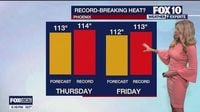As the American Southwest braces for the most intense heat wave of the summer, millions from Phoenix to Los Angeles and Death Valley are facing a dangerous stretch of scorching temperatures, heightened fire risk, and warnings from weather officials and health experts alike. The week of August 18, 2025, marks an extraordinary confluence of meteorological extremes, with triple-digit highs forecasted across Arizona, Southern California, Nevada, and beyond, prompting a wave of heat advisories and urgent safety recommendations.
According to FOX 10 Phoenix, Monday evening in Phoenix was already sweltering, with temperatures climbing to around 108 degrees during the afternoon. While a few showers drifted through southern Arizona overnight, offering brief and localized respite, the overall outlook was clear: things were about to get much hotter. Temperatures are set to soar above 110 degrees later in the week, with Extreme Heat Warnings in effect for southern and western Arizona from Wednesday morning, August 20, through Friday evening, August 22. The Grand Canyon, particularly below 4,000 feet, falls under a special warning from Tuesday through Friday, as the region braces for the peak of the heat wave on Thursday and Friday.
Just across the state line, the National Weather Service Las Vegas issued an Extreme Heat Warning on August 18, effective from 8 a.m. Wednesday until 11 p.m. Saturday. The warning covers a vast swath of territory: Death Valley, the Western and Eastern Mojave Desert, Morongo Basin, Cadiz Basin, San Bernardino County, and the Upper Colorado River Valley. Forecasters expect temperatures around 105 degrees in Kingman, Golden Valley, and Dolan Springs; 110 degrees in Las Vegas, Pahrump, Barstow, Yucca Valley, and Twentynine Palms; 115 degrees in Laughlin, Bullhead City, Needles, and Lake Havasu City; and a blistering 120 degrees at Furnace Creek in Death Valley National Park. The NWS cautions that “minimal overnight relief” is expected, meaning the relentless heat will offer little reprieve even after sunset.
Southern California, meanwhile, is set to experience what Los Angeles Times meteorologists are calling “the most dangerous heat wave of the season so far.” Extreme heat and fire weather advisories have been issued for much of inland Southern California, starting Wednesday, August 20, and lasting for several days. Peak temperatures are expected Thursday and Friday, with downtown Los Angeles forecast to reach 94 degrees, Woodland Hills 108, Los Angeles County valleys and the Inland Empire up to 104, Palm Springs soaring above 113, and Death Valley again bracing for 120 degrees. Meteorologist Ariel Cohen of the NWS Oxnard office described the event as “a once-a-year, once-every-other-year-caliber heat wave,” emphasizing that “everyone needs to be getting prepared now.”
What’s driving this punishing heat? According to weather experts, a high-pressure system is parked over the Southwest, stronger and more persistent than usual. Kristan Lund, another NWS meteorologist, explained that the system’s duration and strength are compounding the threat, keeping temperatures high even overnight. Los Angeles, for instance, could remain in the 70s after dark on Thursday, a situation that poses particular risks to the elderly, pregnant individuals, and outdoor workers who might not have time to recover from the heat before the next day’s onslaught.
Fire risk is also front and center. As the landscape dries out and temperatures spike, the potential for wildfires increases dramatically. Several fires, including the Gifford, Rosa, and Gold fires, are already burning in California. The NWS issued an extreme heat watch for Wednesday through Saturday across Southern California and into the desert Southwest, with special concern for the Los Angeles and Ventura County mountains and foothills. The watch warns that “the unseasonably hot and unstable air mass [is] capable of producing explosive fire behavior.” Ariel Cohen cautioned, “We’re expecting there to be very favorable conditions for fires to grow. The fires start to fuel themselves in this type of environment.”
For residents and travelers, the advice is clear and urgent. The Scottsdale Fire Department and the Arizona Department of Health Services both stress the importance of hydration, staying in air-conditioned spaces, and avoiding strenuous outdoor activity during the hottest parts of the day. Those who must be outside are advised to wear lightweight, light-colored clothing, protect their heads with hats, and keep their cell phones handy. Telling someone your plans before hiking or exercising outdoors is also recommended, as is checking the UV Index and heat risk maps before venturing out.
Recognizing the symptoms of heat-related illnesses can be a lifesaver. Heat cramps are marked by profuse sweating, fatigue, and muscle cramps. Heat exhaustion brings headaches, dizziness, weakness, nausea, and cool, moist skin. The most severe, heat stroke, is characterized by a body temperature above 103 degrees, confusion, dry or hot skin, rapid shallow breathing, and even seizures or unconsciousness. In any suspected heat emergency, the advice is to get the person into shade, cool them with wet cloths and fans, and call 911 if symptoms worsen or if the person is unconscious or unable to swallow.
Driving in these conditions presents its own hazards. The Arizona Department of Transportation recommends keeping your gas tank at least three-quarters full, carrying plenty of water (including frozen bottles for cooling), and ensuring your vehicle is in good working order—especially the air conditioner and tires. If your vehicle breaks down, seek shade, stay hydrated, and call for assistance immediately. Never leave children or pets unattended in a car, as interiors can reach deadly temperatures within minutes.
Outdoor workers, in particular, face heightened risks. The Occupational Safety and Health Administration (OSHA) recommends regular rest breaks in shaded or air-conditioned environments. Employers are urged to ensure their teams are aware of the dangers and have access to necessary resources during the heat wave.
With the high-pressure system expected to linger into early next week, the heat is unlikely to abate quickly. While some meteorologists, like Sam Zuber of the NWS San Diego office, predict a slight cooldown in the days following the peak, temperatures are still expected to remain above normal for this time of year.
In a region accustomed to hot summers, this week’s heat wave stands out for its severity, scope, and the broad swath of communities it threatens. Officials urge everyone to take the warnings seriously, prepare accordingly, and look out for one another as the Southwest weathers the hottest days of 2025 so far.


